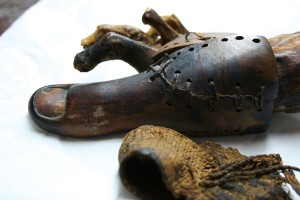
Given the importance that the Ancient Egyptians placed on entering the afterlife intact, it is unsurprising that replacement body parts have been found in tombs. Whether these were used in life, or had a purely cosmetic purpose, has long been the subject of debate, however.
Now an experimental archaeology project at the University of Manchester’s KNH Centre for Biomedical Egyptology has confirmed that two false toes could have served as functional prostheses, making them the earliest ever found. Previously, the oldest-known aid of this kind was a 2,300-year-old Roman false leg made from bronze and wood.

Recently published in the Journal of Prosthetics and Orthotics, the study examined a wood-and-leather toe from c.950-710 BC, found on a female mummy at Luxor, and the British Museum’s Greville Chester toe, which is made from cartonnage (linen, glue, and plaster) and dates to c.600 BC. To investigate signs of wear on the artefacts, researchers created replicas, and leather sandals based on ancient Egyptian examples.
Two volunteers, each missing their big toe, were asked to walk 10m barefoot, in their own shoes, and wearing the toes with and without sandals while project leader Dr Jacky Finch recorded their gait using 10 video cameras, and measured the pressure of their footsteps using a special mat.
Dr Finch noted that the volunteers struggled to walk normally in the replica sandals when they were not wearing the prosthetic toe.

‘This indicates it would have been very difficult for an ancient Egyptian missing a big toe to walk normally wearing traditional sandals,’ she said. ‘They could have remained barefoot or perhaps have worn some sort of sock or boot over the false toe, but our research suggests that wearing these false toes made walking in a sandal more comfortable.’
Wearing the cartonnage prosthesis and sandals, volunteers managed up to 87% of the flexion achieved by their normal left toe, while the wood and leather design produced up to 78%. Although the latter replica performed less well, it was judged to be the more comfortable.
